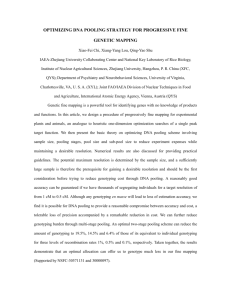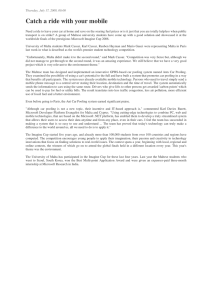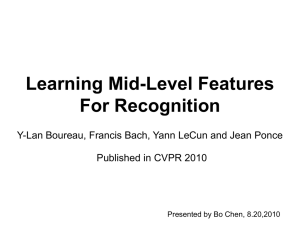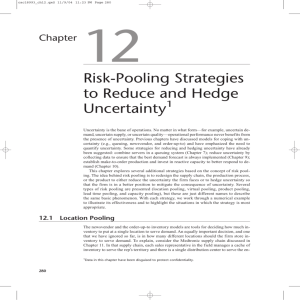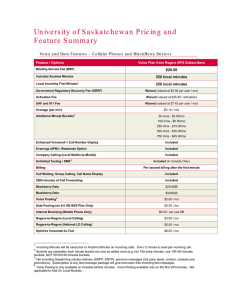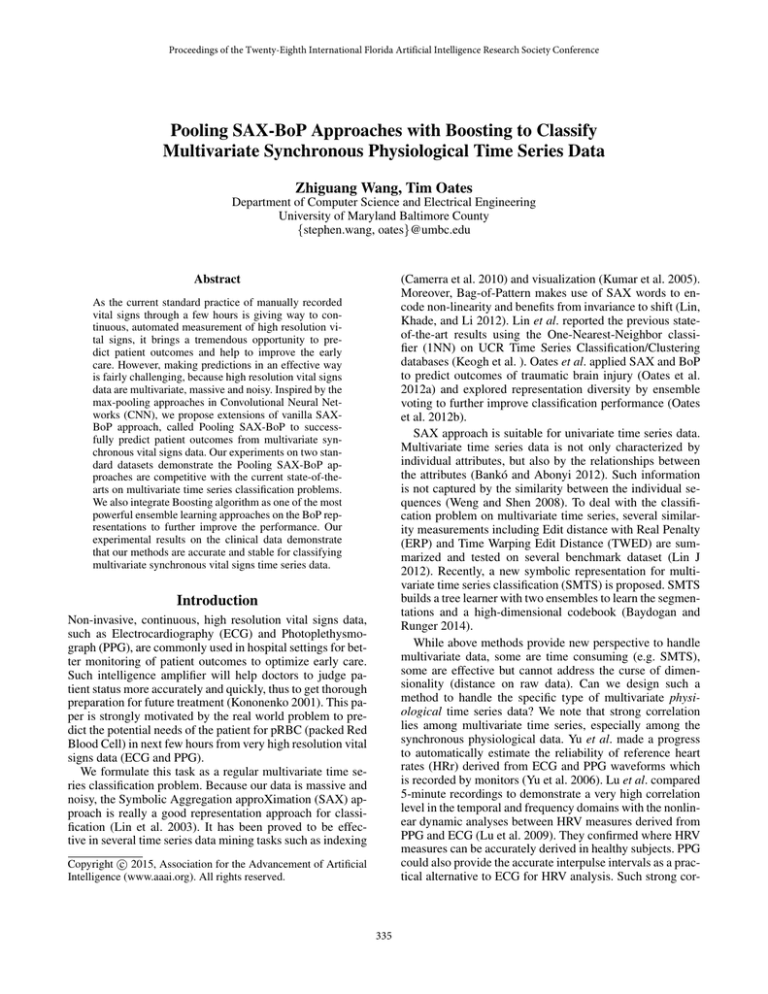
Proceedings of the Twenty-Eighth International Florida Artificial Intelligence Research Society Conference
Pooling SAX-BoP Approaches with Boosting to Classify
Multivariate Synchronous Physiological Time Series Data
Zhiguang Wang, Tim Oates
Department of Computer Science and Electrical Engineering
University of Maryland Baltimore County
{stephen.wang, oates}@umbc.edu
Abstract
(Camerra et al. 2010) and visualization (Kumar et al. 2005).
Moreover, Bag-of-Pattern makes use of SAX words to encode non-linearity and benefits from invariance to shift (Lin,
Khade, and Li 2012). Lin et al. reported the previous stateof-the-art results using the One-Nearest-Neighbor classifier (1NN) on UCR Time Series Classification/Clustering
databases (Keogh et al. ). Oates et al. applied SAX and BoP
to predict outcomes of traumatic brain injury (Oates et al.
2012a) and explored representation diversity by ensemble
voting to further improve classification performance (Oates
et al. 2012b).
SAX approach is suitable for univariate time series data.
Multivariate time series data is not only characterized by
individual attributes, but also by the relationships between
the attributes (Bankó and Abonyi 2012). Such information
is not captured by the similarity between the individual sequences (Weng and Shen 2008). To deal with the classification problem on multivariate time series, several similarity measurements including Edit distance with Real Penalty
(ERP) and Time Warping Edit Distance (TWED) are summarized and tested on several benchmark dataset (Lin J
2012). Recently, a new symbolic representation for multivariate time series classification (SMTS) is proposed. SMTS
builds a tree learner with two ensembles to learn the segmentations and a high-dimensional codebook (Baydogan and
Runger 2014).
While above methods provide new perspective to handle
multivariate data, some are time consuming (e.g. SMTS),
some are effective but cannot address the curse of dimensionality (distance on raw data). Can we design such a
method to handle the specific type of multivariate physiological time series data? We note that strong correlation
lies among multivariate time series, especially among the
synchronous physiological data. Yu et al. made a progress
to automatically estimate the reliability of reference heart
rates (HRr) derived from ECG and PPG waveforms which
is recorded by monitors (Yu et al. 2006). Lu et al. compared
5-minute recordings to demonstrate a very high correlation
level in the temporal and frequency domains with the nonlinear dynamic analyses between HRV measures derived from
PPG and ECG (Lu et al. 2009). They confirmed where HRV
measures can be accurately derived in healthy subjects. PPG
could also provide the accurate interpulse intervals as a practical alternative to ECG for HRV analysis. Such strong cor-
As the current standard practice of manually recorded
vital signs through a few hours is giving way to continuous, automated measurement of high resolution vital signs, it brings a tremendous opportunity to predict patient outcomes and help to improve the early
care. However, making predictions in an effective way
is fairly challenging, because high resolution vital signs
data are multivariate, massive and noisy. Inspired by the
max-pooling approaches in Convolutional Neural Networks (CNN), we propose extensions of vanilla SAXBoP approach, called Pooling SAX-BoP to successfully predict patient outcomes from multivariate synchronous vital signs data. Our experiments on two standard datasets demonstrate the Pooling SAX-BoP approaches are competitive with the current state-of-thearts on multivariate time series classification problems.
We also integrate Boosting algorithm as one of the most
powerful ensemble learning approaches on the BoP representations to further improve the performance. Our
experimental results on the clinical data demonstrate
that our methods are accurate and stable for classifying
multivariate synchronous vital signs time series data.
Introduction
Non-invasive, continuous, high resolution vital signs data,
such as Electrocardiography (ECG) and Photoplethysmograph (PPG), are commonly used in hospital settings for better monitoring of patient outcomes to optimize early care.
Such intelligence amplifier will help doctors to judge patient status more accurately and quickly, thus to get thorough
preparation for future treatment (Kononenko 2001). This paper is strongly motivated by the real world problem to predict the potential needs of the patient for pRBC (packed Red
Blood Cell) in next few hours from very high resolution vital
signs data (ECG and PPG).
We formulate this task as a regular multivariate time series classification problem. Because our data is massive and
noisy, the Symbolic Aggregation approXimation (SAX) approach is really a good representation approach for classification (Lin et al. 2003). It has been proved to be effective in several time series data mining tasks such as indexing
c 2015, Association for the Advancement of Artificial
Copyright Intelligence (www.aaai.org). All rights reserved.
335
relations will greatly simplify the feature fusion procedure
for us. Some work has been proposed to visualize the correlation among multivariate physiological time series data(Ordonez, Adviser-Oates, and Adviser-Desjardins 2012).
Another work that our approaches mainly based on is the
special pooling structure in Convolutional Neural Networks
(CNN), one of the most successful deep learning architectures (LeCun et al. 1989). In this work, we explored to cope
with classification problem on synchronous high resolution
vital signs data based on the new Pooling SAX algorithms
with BoP representations (Pooling SAX-BoP) and Boosting
methods (Freund and Schapire 1995). Our contributions are:
• Extending SAX method to multivariate synchronous vital
signs time series by applying pooling structures. Relying
on the assumption that strong correlation exists among
different variables, Pooling SAX can effectively extract
the principal information among different synchronous
variables.
• Comparing with majority voting (Oates et al. 2012b),
we integrated Boosting algorithm with Pooling SAX-Bop
representations to further improve the ensemble learning
performance on clinical data.
• Proposing a pipeline to process the clinical multivariate
vital signs data on predicting patient outcomes.
Figure 1: PAA and SAX word for the ECG data. The time
series of length 4000 are partitioned into 8 segments. In each
segment we compute means to map them to the equiprobable
interval. After discretization by PAA and symbolization by
SAX, we convert the time series into SAX word sequence
CABDAEBB.
density of each variable and pool out the significant words at
each time. Finally, we use the pooled-out sequence as single
outputs of the multivariate symbolic sequence to build the
BoPs. We call such feature extraction and fusion procedure
the Pooling SAX-BoP approaches.
Definition. Let Xkt denotes a subsequence/bin of time series
in the channel k at time t. Operator G denotes the process
of calculating PAA values in each bin, F is the function to
map PAA values to the corresponding SAX word with respect
to the standard normal distribution N (0, 1). Wk is the nonparametric weights, S is the pooling output.
Given a subsequence/bin in a sliding window of multiple
time series (MTS) X1t , X2t , · · · , Xkt , the pooling functions of
four approaches are given below.
• Max Pooling
KM ax = arg max Wk · F(G(Xkt ))
Pooling SAX-BoP Approaches
The principal idea of SAX is to smooth the input time series
using Piecewise Aggregation Approximation (PAA) and assign symbols to the PAA bins. The overall time series trend
is extracted as a sequence of symbols.
The algorithm requires three parameters: window length
w, number of symbols s and alphabet size a. Different parameters lead to different representations of the time series. Given a normalized time series of length L, we first
reduce the dimensionality by dividing it into [L/w] nonoverlapping sliding windows with skip size 1. Each sliding window is partitioned into s subwindows. Mean values are computed to reduce volume and smooth the noise.
Then PAA values are mapped to a probability density function N (0, 1), which is divided into several equiprobable segments. Letters starting from A to Z are assigned to each PAA
values according to their corresponding segments (1).
After discretization and symbolization, Bag-of-Patterns
(BoP) are built by a sliding window of length w and convert
each subsequence into s SAX words. BoPs catch the features
shared in the same structure among different instance and
regardless of where they occur. We build our features based
on BoP histogram of word counts that is analogous with the
bag-of-words (Wang et al. 2013; Lin, Khade, and Li 2012;
Baydogan, Runger, and Tuv 2013).
k
t
S = F(G(XK
))
(1)
M ax
Considering the toy example, we extract the SAX word,
[a] and [c] from a bin in the bivariate time series. Given
W1 = 0.8, W2 = 0.2, consider [a] × 0.8 = 1 × 0.8 >
3 × 0.2 = [c] × 0.2, so S = [a].
• Min Pooling
KM in = arg min Wk · F(G(Xkt ))
k
t
S = F(G(XK
))
(2)
M in
Considering the same toy example above with the SAX
word [a] and [c]. Given W1 = 0.8, W2 = 0.2, [c] × 0.2 <
[a] × 0.8, then S = [c].
• Max-Min Pooling
After extracting two significant SAX words (their variable
index KM in and KM ax ) from pooling function in Equation. (1) and (2),
t
t
S = [F(G(XK
)), F(G(XK
))]
(3)
M ax
M in
Pooling from Multivariate SAX Word
We proposed a post-processing stage to pool the significant SAX word of each variable with different weighting
schemes that is analogous to multiple pooling structures
for feature extraction in Convolutional Neural Networks
(CNNs). Instead of weights trained by the label, we apply the non-parametric weights to determine the information
336
Table 1: CV error rates on two standard datasets
ECG
wafer
Pooling SAX Max
Pooling SAX Min
Pooling SAX Max-Min
Pooling SAX 3M
SMTS
Euclidean
DTW(full)
DTW(window)
EDR
ERP
LCSS
LCSS Relaxed
TWED
0.115
0.115
0.115
0.115
0.134
0.1778
0.1889
0.1722
0.2
0.1944
0.1278
0.1278
0.1278
Table 2: Test error rates on two standard dataset
ECG wafer
0.0293
0.0168
0.0242
0.0242
0.01
0.0833
0.0909
0.0656
0.3131
0.0556
0.1363
0.1091
0.0318
SMTS
MTSBF
Pooling SAX Max
Pooling SAX Min
Pooling SAX Max-Min
Pooling SAX 3M
K
X
Wk
k=1
Z=
K
X
Z
· F(G(Xkt ))e
(4)
Wk
k=1
Then
t
t
S = [F(G(XK
)), SM ean , F(G(XK
))]
M ax
M in
0.035
0.015
0.02
0.033
0.031
0.039
each channel, average KL-divergence (Kullback and Leibler
1951) measures the difference between the object variable
and other variables. Permutation Entropy (Bandt and Pompe
2002) evaluates the complexity of a given time series. All
these measurements are nonparametric but have different
computation complexity and focus on different aspects. In
this paper, we mainly explore the physiological time series data. As aforementioned discussion, strong correlations
are always observed among different channels/variables.
We care more about the information density in each synchronous variables as they tend to have more significant regulations in synchronous data. Our weight scheme is defined
as the rescaled variance:
PLk
(X t − X¯k )2
Wk = t=1 k
(6)
L
In the above equation, Xkt is rescaled into the interval
[0, 1]. Rescaled variance evaluates the information density
regardless of the magnitude in each channel. This weight
scheme regulates the pooling behavior to extract the significant features while preferring the channels with more information.
After pooling out the single sequence of SAX word from
the multivariate time series, we build the Bag-of-Patterns to
classify the multivariate time series with 1NN classifier.
Considering the same example with the maximum pooling word [a] and the minimum pooling word [c]. then
S = [a, c].
• Max-Min-Mean Pooling (3M Pooling)
Still this need to figure out the significant SAX word
indexKM in and KM ax from pooling function in Equation. (1) and (2), we consider the weighted average of the
SAX word among different channels as
SM ean = d
0.182
0.165
0.16
0.18
0.20
0.18
(5)
Given two synchronous SAX words [a] and [c] with the
weights W1 = 0.8, W2 = 0.2, from Equation. (4),
SM ean = d1 × 0.8 + 3 × 0.2e = 2 = b, then S = [a, b, c]
Experiments on Standard Dataset and High
Resolution Vital Signs Data
Lin et al. compared multiple distance measurements for
classification on multivariate time series and use 10 fold
cross-validation (CV) to evaluate the performance (Lin J
2012). They chose four multivariate time series datasets.
Two of them are too short to use SAX approaches (the average length of ”AUSLAN” is 57 and the lengths of ”Japanese
Vowels” range from 7 to 29). We use the other two dataset
and compare the CV error rate with other approaches (include the current state-of-the-art approach SMTS (Baydogan and Runger 2014)) in Table. 1. Baydogan et al. split
these two dataset as training and testing. They reported the
performance on the training-testing manner with their SMTS
and MTSBF methods. We also train our approach with CV
on the training set and compare the performance on the test
set (Table. 2). Our methods are proved to be quite competitive with the SMTS approach while our approaches are simpler (average running time is 3 hours) without any ensemble
framework. However, SMTS needs two ensembles to learn a
tree-based codebook. Their average running time is reported
to be 18 hours.
Above four pooling approaches are actually inspired from
the pooling architecture in CNNs. Max pooling in CNN attempts to extract the significant weight vectors with respect
to the labels to achieve translation invariance. For multivariate time series, we suppose to pool out the most significant
channels with more information density. Max/Min Pooling
provide us the translation invariance cross multiple channels at the same temporal interval. Max-Min pooling and
3M pooling are much like the multiple K-pooling. The motivation stems from the significance of the extreme values in
time series. 3M pooling combines the average pooling with
multiple K-pooling. In 3M pooling, we suppose to observe
how the weighted average value regulates the behavior of
the BoP representations together with max and min values.
The weight scheme Wk is a series of non-parametric
weights. They decide the significance level of each SAX
word in different channels at the same temporal interval.
We have multiple choices to define Wk . Entropy (Shannon 2001) concerns more about the information density of
337
Best LOOCV ER
0.30
0.25
Best LOOCV Precision
0.9
0.85
0.85
0.20
Best LOOCV Recall
0.9
0.8
0.8
0.15
0.75
0.75
0.10
0.7
0.7
0.05
0.00
0
20
MAX
40
MIN
60
80
MAX-MIN
0.65
100
0
3M
0.65
0.6
MAX
20
40
MIN
60
80
MAX-MIN
100
3M
0
20
MAX
40
MIN
60
80
MAX-MIN
100
3M
Figure 2: Ranked classification error rate/precision/recall of pooling SAX-BoP on 100 bootstrap vital signs dataset.
In the next experiment, we test our approach on the bivariate high resolution vital signs data. The clinical data is collected in the University of Maryland, Medical School. All
the data is anonymous in order to protect the privacy. The
ECG and PPG data of 556 patients were recorded in 68 to
128 minutes long with 240 Hz sampling rate. Default value
(e.g. -31556 when there is no input) and missing value are allowed. The length of 237 samples are less than 128 minutes.
The data is quite massive with more than 1.7 million data
points. The labels indicate if a patient needs blood transfusion of pRBC or not in the next 6 hours. The data is highly
skewed with only 17 positive samples.
Considering the vital signs data is highly periodical, we
preprocess the data second by second. Among 7680 seconds,
we get rid of any interval with the default or missing value.
This may lead to information loss, because some seconds
only contain few missing number or default value. However,
inconsistency caused by missing number and default value
may exert deeper hazard due to the noise and false information. Based on the fact that the normalized time series
has approximate Gaussian distribution (Lin et al. 2003), we
applied variance filter to further regulate the outliers. According to the 3-Sigma rule (Pukelsheim 1994), if a value
locates beyond three times deviations away from the mean,
the probability of that point incurring is naturally lower than
0.27%. Thus, we truncate these outliers to the lower and upper bounds. What we need is the overall trend encoded in
the time series, the last step of preprocessing is calculating
means in each second to reduce the volume and keeping the
overall trend analogously to PAA.
To guarantee the results on our dataset is not biased, we
build 100 new balanced datasets using bootstrap (Manly
2006) by keeping all the 17 positive samples fixed and
randomly choosing 17 negative samples with replacement.
To compare the performance of the Pooling SAX-BoP approaches on clinical data, we also test standard SAX-BoP
approach on each single variable of the vital signs data and
report the statistics of the best 1NN classifier error rate,
precision and recall with Leave-One-Out cross validation
(LOOCV) on the 100 bootstrap dataset (Table . 3).
Figure. 2 shows the ranked curve of classification error rate, precision and recall of four pooling SAX-BoP approaches on 100 resampled bootstrap datasets. In our experiments, except for the Max Pooling, all other three approaches has the equivalent best error rate (0.117) among all
Table 3: The LOOCV statistics of the best performance for
standard SAX-BoP and multivariate Pooling SAX-BoP on
100 bootstrap dataset
PPG
ECG
MAX
MIN
MAX-MIN
3M
Error Rate
Precision
Recall
0.192 ± (0.037)
0.256 ± (0.038)
0.169 ± (0.017)
0.196 ± (0.049)
0.188 ± (0.048)
0.181 ± (0.040)
0.813 ± (0.043)
0.748 ± (0.037)
0.831 ± (0.017)
0.807 ± (0.048)
0.813 ± (0.047)
0.824 ± (0.040)
0.808 ± (0.037)
0.744 ± (0.038)
0.831 ± (0.02)
0.804 ± (0.047)
0.811 ± (0.046)
0.818 ± (0.034)
dataset. Although Max Pooling cannot reach to the best performance as others, it is more stable with slight oscillation
in the performance curve. It also demonstrates better average
statistics with small standard deviation. Our experiments on
the clinical physiological data imply that Pooling SAX-BoP
approaches improve the expressive power of the BoP representations and enhance the classification performance. They
not only demonstrate the competitive state-of-the-art performance on standard datasets, but also work well to solve the
real world problems.
Ensemble Learning on BoP Representations
Using Boosting Algorithm
SAX reduces the dimensionality but also drops much details
in the raw data. The Pooling SAX methods attempt to extract the significant SAX words while preserving the core
information. This means SAX based approaches run the risk
of information loss where the key structures in specific time
series might be discarded, thus leads to the samples to be
misclassified. Some work has been proposed to exploit representational diversity for time series classification via ensembles of the representations (Oates et al. 2012b). We randomly select a balanced dataset to test majority voting approach as a baseline. That is, a subset of those classifiers is
chosen and allowed to vote on the class labels for test set
instances, with the unweighted majority used to predict the
class label. We chose the subset by keeping only those representations with top K lowest error rates of the best representation as measured by 1NN error on the training set.
In Figure. 3 (a), we observe the effect of information loss
in the voting results. As the number of voting agents increase
from 10 to 70, there is no change in LOOCV error rates
for Max Pooilng SAX. The enhancement of performance on
other pooling structures is also not so clear. That is, informa-
338
CV Error Rate of Majority Voting on
Pooling SAX-BoP
0.25
CV Error Rate of Boosting on
Pooling SAX-BoP
0.25
0.20
0.2
0.15
0.15
0.10
0.1
0.05
0.05
0.00
0
10
30
MIN
MAX
50
MAX-MIN
70
1
3M
3
MIN
5
MAX
7
MAX-MIN
9
3M
Figure 3: LOOCV Error Rate of a) majority voting (left) and b) Boosting (right) with Pooling SAX-BoP approaches on vital
signs data.
tion loss leads to the failure to interpret key features among
the top Pooling SAX-BoP representations.
CV Error Rate of Boosting on Pooling SAX-BoP and Multifrequency VS data
0.25
Boosting on Pooling SAX-BoP Representations
0.2
To address misclassification caused by feature missing in
the Pooling SAX-BoP approaches, we apply Boosting algorithm to build a non-linear classifier (Freund, Schapire,
and others 1996). Boosting adaptively changes the sample
weights according to previous classification results to focus on the toughest samples. The missing feature dimension
caused by information loss is hit by the larger weight during
the iterative process. Instead of increasing the dimensionality of the feature space in kernel methods, we use Boosting to tune the linear classification hyperplane of several
weak classifiers into a nonlinear classification hyperplane
by weighted summation. Despite of missing dimension, the
nonlinear hyperplane potentially classify some tough samples in the linear situations.
We apply a slightly modified version of Boosting algorithm for SAX-BoP representations to classify the balanced
vital signs dataset. The trick is to combine each SAX-BoP
patterns with a 1NN classifier as a weak learner in Boosting algorithm. What Boosting does for 1NN classifier is to
create an ensemble of models with locally modified distance
weighting (Athitsos and Sclaroff 2005). After approximately
10 turns voting, the converged performance is significantly
enhanced (Figure 3 (b)).
Recall that we preprocessed high resolution vital signs
data by averaging in each second interval. If voting through
the diversity of BoP representation enrich the information
and enhance the performance, multiple preprocessing frequencies can also capture different temporal information in
the vital signs data, respectively. In preprocessing stage, we
calculate the mean value in each 1 , 0.5 and 0.3 second interval and combine the Pooling SAX-BoPs on these three
preprocessing frequencies together into one large dataset.
Because better weak learner will be selected in each iteration from the samples of three resampling frequencies, different resampling rate will mix various temporal diversity
into Boosting algorithm to further enhance the classification
performance and accelerate the converge speed (Figure.4).
0.15
0.1
0.05
0
1
2
3
MIN
4
MAX
5
6
MAX-MIN
7
8
9
10
3M
Figure 4: LOOCV Error Rate of Boosting algorithm with
Pooling SAX-BoP approaches on the vital signs data of multiple frequency.
Boosting runs the risking of overfitting. The direct application of VC theory shows that boosting can work well if
providing simple weak classifiers which satisfy the weak
learning condition, and if running for enough but not too
many rounds (Schapire 2013). We update the error rate from
the optimal SAX-BoP representation and 1NN classifiers
with the higher accuracy than 50%. The convergence curve
in Figure. 3 (b) shows that Boosting algorithm in our case
does not need many iterations (About 10 turns) to converge
to its stable performance. We applied the fully trained Boosting classifier on the balanced dataset of multiple frequency
to classify the fully 556 samples. The Boosting classifier
achieved 4.856% error rate. Meanwhile, predicting using the
trained Boosting classifier is very fast and convenient for
real-time classification of physiological data in a second-bysecond manner.
Conclusion and Future Work
In this paper, we proposed the pooling SAX-BoP with
Boosting algorithm to solve classification problem on the
multivariate vital signs time series data. The experiments
on two standard datasets and the clinical vital signs data
339
demonstrate the effectiveness and efficiency of the Pooling
SAX-BoP approach. Our approach achieved competitive results with two current state-of-the-art multivariate time series classifiers. Instead of majority voting, Boosting algorithm is applied to significantly improve the performance.
Future work includes exploring the correlation between
multivariate vital signs data through statistics and feature
selection technique to further improve the performance. We
also plan to explore more clinical vital signs data to predict
patient outcomes.
tion applied to handwritten zip code recognition. Neural
computation 1(4):541–551.
Lin, J.; Keogh, E.; Lonardi, S.; and Chiu, B. 2003. A
symbolic representation of time series, with implications
for streaming algorithms. In Proceedings of the 8th ACM
SIGMOD workshop on Research issues in data mining and
knowledge discovery, 2–11. ACM.
Lin J, Williamson S, B. K. D. D. 2012. Pattern recognition
in time series. Chapman & Hall, To appear.
Lin, J.; Khade, R.; and Li, Y. 2012. Rotation-invariant similarity in time series using bag-of-patterns representation.
Journal of Intelligent Information Systems 39(2):287–315.
Lu, G.; Yang, F.; Taylor, J.; and Stein, J. 2009. A comparison of photoplethysmography and ecg recording to analyse
heart rate variability in healthy subjects. Journal of medical
engineering & technology 33(8):634–641.
Manly, B. F. 2006. Randomization, bootstrap and Monte
Carlo methods in biology, volume 70. CRC Press.
Oates, T.; Mackenzie, C. F.; Stansbury, L. G.; Aarabi, B.;
Stein, D. M.; and Hu, P. F. 2012a. Predicting patient outcomes from a few hours of high resolution vital signs data.
In Machine Learning and Applications (ICMLA), 2012 11th
International Conference on, volume 2, 192–197. IEEE.
Oates, T.; Mackenzie, C. F.; Stein, D. M.; Stansbury, L. G.;
Dubose, J.; Aarabi, B.; and Hu, P. F. 2012b. Exploiting representational diversity for time series classification. In Machine Learning and Applications (ICMLA), 2012 11th International Conference on, volume 2, 538–544. IEEE.
Ordonez, P.; Adviser-Oates, T.; and Adviser-Desjardins, M.
2012. Multivariate time-series analysis of physiological and
clinical data. University of Maryland at Baltimore County.
Pukelsheim, F. 1994. The three sigma rule. The American
Statistician 48(2):88–91.
Schapire, R. 2013. Explaining adaboost. In Schlkopf, B.;
Luo, Z.; and Vovk, V., eds., Empirical Inference. Springer
Berlin Heidelberg. 37–52.
Shannon, C. E. 2001. A mathematical theory of communication. ACM SIGMOBILE Mobile Computing and Communications Review 5(1):3–55.
Wang, J.; Liu, P.; She, M. F.; Nahavandi, S.; and Kouzani,
A. 2013. Bag-of-words representation for biomedical time
series classification. Biomedical Signal Processing and Control 8(6):634–644.
Weng, X., and Shen, J. 2008. Classification of multivariate time series using locality preserving projections.
Knowledge-Based Systems 21(7):581–587.
Yu, C.; Liu, Z.; McKenna, T.; Reisner, A. T.; and Reifman, J.
2006. A method for automatic identification of reliable heart
rates calculated from ecg and ppg waveforms. Journal of the
American Medical Informatics Association 13(3):309–320.
References
Athitsos, V., and Sclaroff, S. 2005. Boosting nearest
neighbor classifiers for multiclass recognition. In Computer
Vision and Pattern Recognition-Workshops, 2005. CVPR
Workshops. IEEE Computer Society Conference on, 45–45.
IEEE.
Bandt, C., and Pompe, B. 2002. Permutation entropy: a
natural complexity measure for time series. Physical Review
Letters 88(17):174102.
Bankó, Z., and Abonyi, J. 2012. Correlation based dynamic
time warping of multivariate time series. Expert Systems
with Applications 39(17):12814–12823.
Baydogan, M. G., and Runger, G. 2014. Learning a symbolic representation for multivariate time series classification. Data Mining and Knowledge Discovery 1–23.
Baydogan, M. G.; Runger, G.; and Tuv, E. 2013. A
bag-of-features framework to classify time series. Pattern
Analysis and Machine Intelligence, IEEE Transactions on
35(11):2796–2802.
Camerra, A.; Palpanas, T.; Shieh, J.; and Keogh, E. 2010.
isax 2.0: Indexing and mining one billion time series. In
Data Mining (ICDM), 2010 IEEE 10th International Conference on, 58–67. IEEE.
Freund, Y., and Schapire, R. E. 1995. A desiciontheoretic generalization of on-line learning and an application to boosting. In Computational learning theory, 23–37.
Springer.
Freund, Y.; Schapire, R. E.; et al. 1996. Experiments with a
new boosting algorithm. In ICML, volume 96, 148–156.
Keogh, E.; Zhu, Q.; Hu, B.; Hao, Y.; Xi, X.; Wei, L.;
and Ratanamahatana, C. The ucr time series classification/clustering, 2011. Homepage:¡ http://www. cs. ucr.
edu/eamonn/time series data.
Kononenko, I. 2001. Machine learning for medical diagnosis: history, state of the art and perspective. Artificial Intelligence in medicine 23(1):89–109.
Kullback, S., and Leibler, R. A. 1951. On information and
sufficiency. The annals of mathematical statistics 79–86.
Kumar, N.; Lolla, V. N.; Keogh, E. J.; Lonardi, S.; and
Ratanamahatana, C. A. 2005. Time-series bitmaps: a practical visualization tool for working with large time series
databases. In SDM, 531–535. SIAM.
LeCun, Y.; Boser, B.; Denker, J. S.; Henderson, D.; Howard,
R. E.; Hubbard, W.; and Jackel, L. D. 1989. Backpropaga-
340



